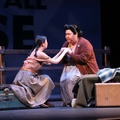Part 4 >>
Spirits spiked and plummeted throughout the next several months that included the anxiety-ridden voyage aboard the Florida from Panama to New Orleans followed by long hours on a train through desolate territory to an unknown destination. A high point for the prisoners occurred on the train. An American soldier, fooling around by balancing his weapon on his palm, dropped the gun and watched it fall through a gap under a door. The prisoners expected to see harsh punishment doled out but no recrimination beyond an extra shift of K.P. duty fell to the clumsy soldier. The train continued, leaving the gun on the tracks, while the Japanese puzzled over the lax American attitude towards valuable weapons.
The train carrying the one hundred Panamanian Japanese prisoners passed through Texas and arrived at Fort Sill in Oklahoma. Amano described the facility as 192 tents and 13 barracks, “lined up like go game pieces” on barren land, surrounded by a double layer of barbed wire fencing, nine-foot high, and a guard tower with machine guns, “loaded and uncovered and ready to shoot us anytime.” A group of 169 Japanese prisoners from Hawaii greeted the new arrivals.
From this point in Waga Toraware No Ki, Amano almost always referred to the prisoners by group, reflecting the value placed on the concept of group in Japan, i.e. the Panama group and the Hawaii group. Conditions at Ft. Sill were a step up from Balboa, with good food, served on porcelain dishes. Amano “felt proud to be promoted from animal to human.” He was surprised that camp officials permitted the prisoner to use knives, forks and spoons.
Soon, another group from Fort Missoula, Montana, arrived. Originally from California, the 352 prisoners making up the Missoula group had been considered dangerous and, according to Amano, “the worst of the worst.” The Panama group, dressed “like beggars,” formed a welcome party but it turned out that the new arrivals were extremely well dressed, carrying unscuffed suitcases, golf bags and portable radios. “Who was trying to comfort whom?” Amano wondered. “We needed it more.” This was the first exposure the Japanese Latin American prisoners had to Japanese Americans. Amano did not comment further on the apparent disparities in privilege.
The three groups of prisoners banded together by celebrating their shared cultural heritage. Because the officers at Fort Sill did not demand the long hours of hard labor ordered by the staff at Balboa, the prisoners had time for many leisure pursuits. Amano especially enjoyed the talent shows that featured traditional Japanese acts: nani wa bushi (singing), shigin (poetry), biwa (an ancient stringed instrument), rakugo (stand-up comedy), haota (ancient songs), kowairo (impersonators), dojosukui (a comical dance), and shakuhachi (traditional flute). Some of the Japanese American prisoners had been professional musicians. INS officials had allowed the musicians to keep their instruments in camp along with supplies of yokan (rice candy) and tea that they shared with the destitute Latin Americans.
The standing-room-only shows provided a brief respite from fear and worry but reality soon intruded with three deaths in camp. The first prisoner to die, Ochi Yakuji, had been ill in Panama. Taken by medics to Ancon Hospital, he returned five days later, diagnosed with untreatable cancer of the tongue. Amano claimed the U.S. Army denied Ochi’s request for a last visit from his wife and child and forced him to join the rest of the Panamanian prisoners at Fort Sill. Amano recalled that Ochi “begged many times for the soldiers to kill him.” He also charged the Fort Sill physicians with only coming to Ochi’s tent to determine if he was dead or alive. Amano described his final day:
April 30. Ochi was taken to the hospital. We all lined up to give him a send-off. He waved weakly from the stretcher. He looked like a mummy swinging his arm in the air. That’s the last time we saw him alive. He died on May 1. We all knew tongue cancer killed him but so did American indifference. When he died, he was alone. Such a lonely, sad way to die. His body was buried in an Oklahoma field. I’m sure his marker would soon rot and the weeds would take over. Surely, even if peace ever came to this world, his wife and family would not be able to find him. That evening was cold and rainy. Where would his soul travel?
The next casualty, Oshima Ken Saburo occurred ten days later.
Historian Tetsuden Kashima, in Judgment Without Trial, counted the death of Kanesaburo Oshima as one of seven internee homicides committed by U.S. military personnel. Kashima dated the incident on May 13, 1942, one day later than Amano, and provided some background information for Oshima’s erratic behavior. Other details of the event at Fort Sill are largely in agreement. Amano’s version read:
May 12, 8:00 a.m. Oshima Ken Saburo, what was he thinking? He tried to climb over the gate. It happened so suddenly. The guard and the watchtower soldier were surprised but in a second, a terrible thing happened. The guard pulled a pistol on Oshima as he ran between the barbed wire fences and threw himself halfway up the outer gate but the overhanging barbed wire stopped him. Even if no one did a thing to stop him, Oshima wouldn’t have succeeded. We shouted, “don’t shoot. He’s crazy!” The watchtower guard lowered his gun but the other guard shot him from three meters away. Oshima’s body dropped to the ground. The medics later said a second shot went through his head. The Fort Sill weeds absorbed Japanese blood then but bad things always happen in threes.
Amano listed Shimoda Itsuji, the third camp death, as a witness to Oshima’s death.
Numerous sources ascribe Oshima’s personal history and death to Shimoda, confusing the two men and counting their separate deaths as one. However, Kashima’s research corroborates the account in Waga Toraware No Ki. Amano believed that Shimoda died under suspicious circumstances after suffering a nervous breakdown in a military hospital five days after witnessing Oshima’s murder. Military officers refused prisoner requests to see the body. However, some camp administrators delivered flowers and condolences to the prisoner, derided by Amano as too little, too late. “We needed kindness while we were alive. If they had showed any compassion first there would be no need to bury bodies out here.”
The military granted permission for prisoner-conducted funerals. The funerals galvanized the prisoners’ fear and anger into a renewed connection with their Japanese ancestors. Amano described the rituals:
Before the casket was sent to the cemetery, it was brought to a tent. All the prisoners solemnly viewed the pallbearers. About sixty ministers and priests of all denominations, mostly from Hawaii, followed the casket. About two-thirds of the way down the path, the casket was placed on a table covered by a white cloth. At both sides, flowers were placed. Small wooden plaques with the departed’s name, as in shrines, were placed near the casket. Then, the priests started to chant but not of the usual kind for funerals. More than sympathy for the dead, the chanting communicated anger at the Americans. The suffering of all prisoners came through in the chants. Many people were crying. Yamada read the eulogy. Incense and prayers followed. The incense smoke swirled and rose like a soul approaching the May sky. We returned the way we arrived, handing the casket back to the army soldiers, offering a last prayer. After the hearse cleared the gate, we still stood there for a long time and mourned.
The eulogies provided a platform to express resentment and outrage. One prisoner, identified only as “A,” delivered a eulogy that, at length, denounced and repudiated the United States’ claim to moral superiority. He insisted Japan did not kill without a motive compared to an American soldier casually gunning down a mentally ill inmate. “A” rallied the prisoners with a call for the Imperial Japanese Army to defeat the Americans. These statements, delivered in Japanese, went unnoticed by the guards.
© 2010 Esther Newman





